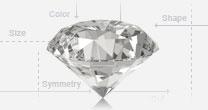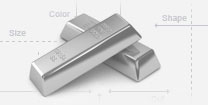- Diamonds
- Engagement
- Jewelry
- Education
- Learn about Diamonds
- Learn about Metals
- What to expect when buying a ring
- Custom Design Process
- The Diamond 4 C's
- How To Care For Your Jewelry
- How To Plan A Wedding
- Picking an Engagement Ring
- Top 10 Ways To Propose
- The Meaning Behind Shapes and Colors of Diamonds
- Advice for Grooms
- The Natural History, Mythology, and Symbolism of Popular Gemstones
- The Bridal Style Checklist
- The Economics of Engagement Rings
- How to Keep Your Diamonds Safe from Theft or Damage
- How to Create the Perfect Christmas Proposal
- The Secret Guide for Authentic Engagement Photos
- How to Plan the Perfect Marriage Proposal
- Best Seasons to Get Married In
- About Us
Advanced Features Guide
Aside from the better-known 4 C's, there are additional features which affect the quality and appearance of a diamond. These features need to be taken into consideration where one is trying to pick the perfect diamond. We assembled the following advanced features that may provide you with guidance in picking your diamond and will give you a better understanding of the information found on the diamond certificate. These features include a diamond's depth, polish, table, symmetry, and fluorescence.
A Diamond's Depth Percentage
The depth percentage of a diamond is computed by dividing the diamond's overall height (measure from table to culet) by the diamond's diameter. For diamonds that are not round, the depth percentage is computed by dividing the height by the shorter side of the diamond. The depth percentage of a diamond affects its appearance in a number of manners. First of all, it affects the brilliance of the stone and its ability to return light properly. If the diamond depth percentage is low, light will not reflect off it as well as it would reflect off a diamond with a higher depth percentage. The ideal diamond depth percentage falls between 59%-63.8%. The diamond's depth percentage is only one feature that affects the diamond's ability to return light. If size matters to you then keep in mind that a diamond that isn't as deep will appear larger than a diamond that is deeper when they bear the same carat weight.
A Diamond's Polish
Polish does not have a major effect on its price but contributes greatly to its overall appearance. Diamonds have a grain to them and in that respect are similar to wood, and to remove that grain the diamond needs to be polished. A diamond that is polished better enables light to pass through it and contributes to the diamond's shine. Polish levels of Good, Very Good and Excellent will promote a brilliant appearance in the diamond and will have polish lines (the lines of the diamond graining on the surface) that can only be seen under 30X magnification or higher. The polish lines found in diamonds that are Fair or Poor will inhibit light from traveling through the diamond and cause it to appear more cloudy. The difference a proper polish can make in a stone's brilliance can be astounding.
A Diamond's Table Percentage
The table of a diamond is the flat plateau facet at the top of the stone. Table Percentage refers to the ratio of the table width to the total diameter of the diamond, and has a significant effect on the brilliance and fire of the diamond. For round brilliant diamond cut, the ideal table size ranges between 53-58% of the diamond's overall width. Other diamond shapes have different ranges of ideal table size.
A Diamond's Symmetry
Symmetry is an all-encompassing measure of the diamond's number of facets, positioning of the table, shape of its girdle and the shape of its facets. Symmetry levels range from Extremely Poor to Excellent. It is important to try and obtain a diamond that has a symmetry between Good and Excellent. The symmetry does not govern the extent to which the diamond can return light and look brilliant but it does strongly influence the "pattern" of that light return where more symmetrical diamonds are better able to return a focused and visually pleasing light return pattern that does not look blotchy and out-of-sync.
A Diamond's Fluorescence
The attribute of Fluorescence is found in approximately 25% of all diamonds to some extent. Fluorescence is a photoluminescent attribute of the diamond, meaning that it appears only under certain types of light and in the case of blue fluorescence (the most common form) it appears under short-wave UV radiation. Fluorescence in diamonds can vary from Faint to Very Strong. When blue fluorecent diamonds are placed under the short-wave UV light they exhibit a bluish glow whose intensity determines the overall Fluorescence rating of the diamond. Diamonds that are rated as either Strong or Very Strong may appear cloudy especially when the diamond is very white to begin with (usually D-F colors). Diamonds that have a tinge of yellow can have an improved appearance from the fluorescence that will tend to mask the diamond's natural yellowness.










